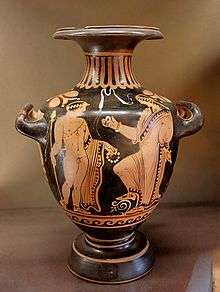Hydria


A hydria (Greek: ὑδρία; plural hydriai) is a type of water-carrying vessel in the metalwork and pottery of Ancient Greece. The hydria has three handles. Two horizontal handles on either side of the body of the pot were used for lifting and carrying the pot. The third handle, a vertical one, located in the center of the other two handles, was used when pouring water. If the third handle is missing, the type is called a kalpis. This water vessel can be found in both red- and black-figure technique. They often depicted scenes of Greek mythology that reflected moral and social obligations. As well as holding water hydriai could be used for holding ashes in burials and collecting ballots in elections.[1]
By the mid-5th century BC, Greek artisans were also creating hydria from bronze, some of which were elaborately decorated with finely detailed figures. A 6th-century example is in the Historisches Museum, Berne.[2] Such vessels were also known from Minoan pottery.
Regina Vasorum ("Queen of Vases") is a famous late (4th century BC) hydria in the Hermitage Museum, found in Italy.
Purpose
The design was altered to serve a more practical purpose around the mid 6th-century B.C.E. The shape of the Hydria was altered from having a wide body and broadly rounded shoulders, to a design that incorporated flatter shoulders that met the body at an angle. This was done to ease the task of carrying water to and from the home and places of gathering. In ancient Greece, as well as carrying water, the vase was used to dilute wine. It was perceived as uncultured to drink undiluted wines at gatherings.[3]
See also
References
| Wikimedia Commons has media related to Hydriai. |
- ↑ "Hydria", Classical Art Research Centre, Oxford, Beazley Archive
- ↑ Cunliffe, Barry, The Ancient Celts (Penguin, 1999), fig. 36 on p. 53.
- ↑ Hemingway, Authors: Seán Hemingway, Colette. "Greek Hydriai (Water Jars) and Their Artistic Decoration | Essay | Heilbrunn Timeline of Art History | The Metropolitan Museum of Art". The Met’s Heilbrunn Timeline of Art History. Retrieved 2018-04-05.
External links